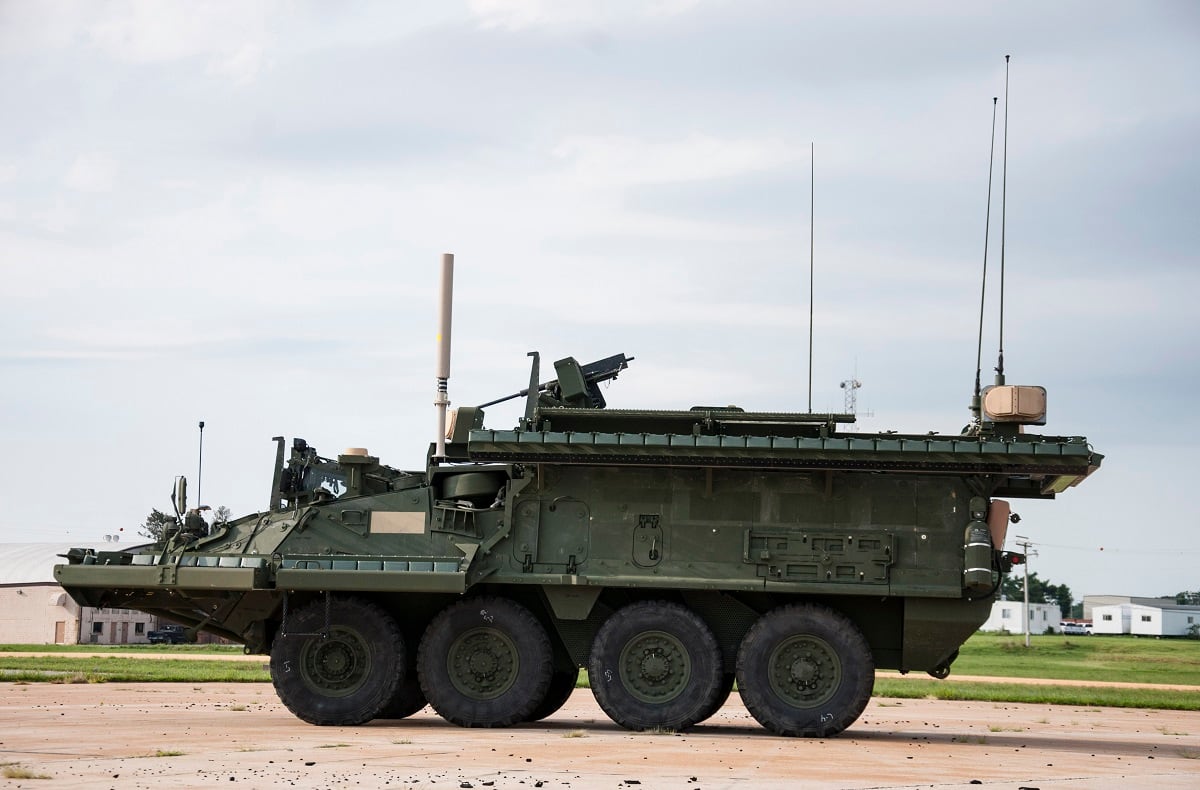WASHINGTON — Based on what has been observed of Russia’s invasion of Ukraine, the U.S. Army in Europe has renewed interest in pursuing active hard-kill protection systems for its Stryker combat vehicle, something the service put on the backburner years ago.
Beginning in 2016, the Army evaluated Active Protection Systems that could provide increased protection for Stryker. It decided in 2019 to place the effort on hold after evaluating several possible solutions.
“There is a renewed interest in a hard-kill APS for the Stryker forces in Europe,” said Col. William Venable, project manager for the Stryker Brigade Combat Team within the Army’s Program Executive Office Ground Combat Systems. He spoke at a conference in Arlington, Virginia, focused on future active protection for armored vehicles on June 2.
The interest from the European theater flowed back to his office, Venable said The Army asked for feedback on requirements for a system that can be rapidly fielded much like the service did to up-gun the Stryker with a 30mm cannon, known as a Dragoon, and also with a Common Remote Weapon System using Javelin anti-tank missiles.
The Army moved quickly on both programs amid urgent operational needs from the 2nd Cavalry Regiment in Europe following Russia’s annexation of Crimea in 2014. Anticipating Russian capability, the Army called for the rapid fielding of greater firepower capability for its maneuver forces.
While the Army planned to field APS on M1 Abrams tanks, Bradley Infantry Fighting Vehicles and Stryker, it only successfully fielded the Rafael-made Trophy APS system on the Abrams.
The Army still has a small congressional plus-up of $16 million in fiscal 2022 to continue evaluations and work on the IMI-made Iron Fist system for Bradley. The service provided no subsequent funding for the program in FY23 and beyond, budget documents show.
For Stryker, the Army evaluated Herndon, Virginia-based Artis Corporation’s Iron Curtain before determining it was not the right system for the vehicle.
The service then evaluated Rheinmetall’s Active Defense System and Rafael’s Trophy VPS for Stryker but did not move forward with either due to limitations and challenges. One of the larger issues is that several solutions defeat threats very close in to the vehicle, leaving dismounted soldiers walking around outside vulnerable.
Venable said there is a gap in the service’s understanding of the performance requirements for hard-kill APS systems on Stryker vehicles.
“How does it interact with the vehicle? What are the residual effects of hard-kill APS systems on a vehicle and how does it affect the mission of the formation of infantry soldiers that are operating around the vehicle,” are the questions with which the service is wrestling, he said.
Lacking the answer to those questions wouldn’t necessarily prohibit the Army from being able to move forward in rapidly fielding an APS system on Stryker, Venable told Defense News at the conference.
“We have some potential solutions,” he said. “If we have to go fast, I don’t know if we need to solve those problems to go fast. If we have to go fast, there are some effective solutions that are out there today and that can be integrated quickly.”
The Army would include safety and operating restrictions as part of an urgent fielding, he noted.
Venable added that while a system could be rapidly fielded due to an urgent need, more would need to be done if the capability was to turn into a program of record, including a higher level of testing and evaluations and would need to meet a greater percentage of operating requirements.
The Army’s original plan in 2016 was to field APS on Abrams, Bradley and Stryker quickly over a couple of years while developing a future integrated vehicle protection suite for current and future fleets. While the service has tried to move quickly for both the interim and the integrated modular APS system both schedules have continued to slip.
Yet still moving out on a future capability, the Army held a rodeo with vendors in 2021 for a laser warning capability for the system. It selected Danbury Mission Technologies’ AN/VVR-4 Laser Detecting Set in February. The company was part of Collins Aerospace but was spun-off during the United Technologies Corporation and Raytheon merger.
The laser warning capability is the first of its type to be integrated with the Army’s common interface and controller, which Lockheed Martin is developing after winning a contract in February 2021.
Base kit integration is to take place through FY24 across Bradley, Abrams, Stryker and the Armored Multipurpose Vehicle. A procurement contract award will take place in the second quarter of FY23, according to budget documents.
The service has fielded Abrams tanks with APS in Europe for two years. The systems participated in exercises and live-fire demonstrations since deploying to the theater.
Jen Judson is an award-winning journalist covering land warfare for Defense News. She has also worked for Politico and Inside Defense. She holds a Master of Science degree in journalism from Boston University and a Bachelor of Arts degree from Kenyon College.





